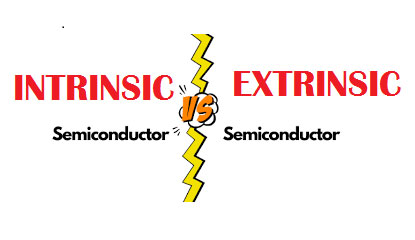Introduction
In the world of electronics, semiconductors are fundamental building blocks that make modern technology possible. Understanding intrinsic and extrinsic semiconductors is crucial for anyone involved in electronics, electrical engineering, renewable energy, or advanced materials research.
This article explores these two critical types of semiconductors in-depth, offering a clear understanding, real-world applications, updated industry insights, and SEO-rich content to ensure you gain the best knowledge available in 2025.
What Are Semiconductors?
A semiconductor is a material whose electrical conductivity lies between that of a conductor and an insulator. Semiconductors are sensitive to temperature, light, magnetic fields, and impurities, making them extremely versatile for various electronic applications.

Intrinsic Semiconductors
Definition
An intrinsic semiconductor is a pure semiconductor without any significant dopant atoms present. It relies solely on the structure of the semiconductor material itself (like Silicon or Germanium) to conduct electricity.
Examples:
- Pure Silicon (Si)
- Pure Germanium (Ge)
Characteristics
- High resistivity at room temperature
- Equal number of electrons and holes
- Electrical conductivity increases with temperature
Working Principle
At absolute zero (0 K), intrinsic semiconductors behave like perfect insulators. As the temperature rises, thermal energy excites some electrons from the valence band to the conduction band, creating free electrons and holes.
Real-World Applications
- Temperature sensors
- High-temperature electronics
- Fundamental studies in semiconductor research
Advantages
- Pure material without dependency on external doping
- Predictable behavior under controlled conditions
Disadvantages
- Low conductivity at room temperature, making them impractical for most electronic devices without modification
Extrinsic Semiconductors
Definition
An extrinsic semiconductor is formed when a small amount of impurity (doping element) is added to an intrinsic semiconductor to change its electrical properties.
Examples:
- Silicon doped with Phosphorus (n-type)
- Silicon doped with Boron (p-type)
Characteristics
- Higher conductivity than intrinsic semiconductors
- Conductivity is controlled by dopant type and concentration
- Can be tailored for specific electrical properties
Types of Extrinsic Semiconductors
1. N-Type Semiconductor
- Doped with pentavalent atoms (e.g., Phosphorus, Arsenic)
- More electrons (negative charge carriers)
2. P-Type Semiconductor
- Doped with trivalent atoms (e.g., Boron, Gallium)
- More holes (positive charge carriers)
Real-World Applications
- Transistors (MOSFETs, BJTs)
- Solar cells
- LEDs
- Diodes
- Integrated circuits (ICs)
Advantages
- Tunable conductivity for desired electronic properties
- Essential for almost all modern electronics
Disadvantages
- Material quality depends on precise doping control
- Susceptible to defects during the doping process
Intrinsic vs Extrinsic Semiconductors: Comparison Table
| Feature | Intrinsic Semiconductor | Extrinsic Semiconductor |
|---|---|---|
| Purity | 100% pure material | Doped with impurities |
| Charge Carriers | Equal electrons and holes | Majority carriers (electrons or holes) |
| Conductivity | Low | High |
| Examples | Pure Silicon, Pure Germanium | Doped Silicon (n-type, p-type) |
| Applications | Research, sensors | Electronics, Solar Cells, LEDs |
Industry Trends in 2025
In 2025, semiconductor technologies have drastically evolved. While silicon remains dominant, compound semiconductors (like GaN, SiC) are rapidly gaining ground, especially in power electronics and high-frequency applications.
Emerging trends:
- Growth of wide-bandgap extrinsic materials
- Increased focus on low-defect-density doping methods
- Use of machine learning in semiconductor doping process optimization
FAQs
Q1: What is the main difference between intrinsic and extrinsic semiconductors?
Intrinsic semiconductors are pure, while extrinsic semiconductors are doped to improve their conductivity.
Q2: Why are intrinsic semiconductors not widely used in devices?
Their low conductivity at room temperature makes them impractical without doping.
Q3: What are examples of intrinsic semiconductor materials?
Pure Silicon and Pure Germanium.
Q4: What type of doping creates an n-type semiconductor?
Doping with pentavalent elements like Phosphorus.
Q5: Are extrinsic semiconductors used in solar panels?
Yes, primarily in the form of doped silicon cells.
Conclusion
Understanding intrinsic and extrinsic semiconductors is essential for grasping the basics of modern electronics. While intrinsic materials set the theoretical foundation, extrinsic semiconductors have powered real-world innovations from microchips to solar panels.
As we step deeper into 2025 and beyond, mastering these fundamentals is crucial for anyone diving into semiconductor materials used in electronics.
Written by: https://top10electrical.com/
Reviewed: 2025
Source: Power Electronics, 4th Ed., Muhammad H. Rashid 【6†source】

